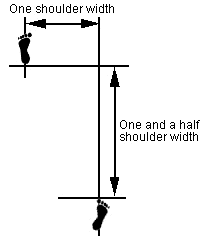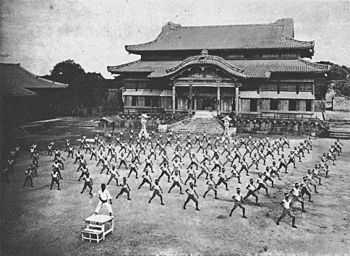Front stance
| Front stance |
|---|
 |
| Typical foot placement for a front stance |
| Japanese name |
| Kanji: |
前屈立ち |
| Hiragana: |
ぜんくつだち |
| Transliterations |
|---|
| - Revised Hepburn: |
zenkutsu-dachi |
| - Kunrei-shiki: |
zenkutu-dati |
|
| Korean name |
| Hangul: |
앞 굽이 |
| Transliterations |
|---|
- Revised
Romanization: |
ap kubi |
|
Front stance, sometimes also called forward leaning stance or forward stance, is a basic stance used in various Asian martial arts. Although the specifics of the stance vary by style, overall it is visually similar to a lunge, with the forward leg bent at the knee, and the rear leg straight, while the hips and shoulders remain squarely facing forward. The purpose of the stance is to teach musculo-skeletal alignment that adds as much mass of the earth to a strike as possible. The stance allows a great deal of power generation forward, but very little in any other direction.
Japanese martial arts

Karate students training in front stance at Shuri Castle, c.1938
In Japanese martial arts, the front stance (前屈立ち, zenkutsu-dachi) is primarily practiced in karate and its variants. Some variations include the version practiced by Shotokan, where students generally place their feet at a longer depth, while Isshin-ryū students place their feet shoulder width, but with much shallower length. Other variations are also practiced.
The front stance is normally used when moving forwards while back stance is used when moving backwards.
Korean martial arts
The front stance is primarily practiced by students of taekwondo, where it is called ap kubi.

